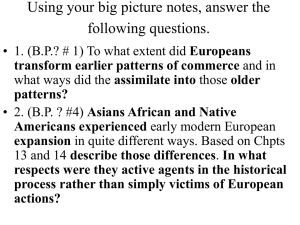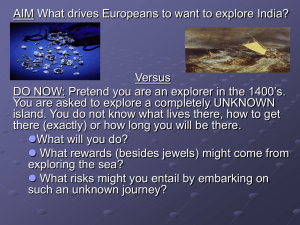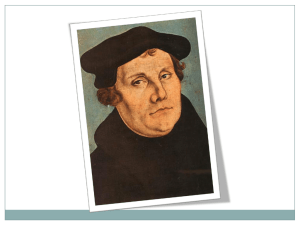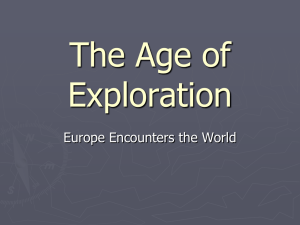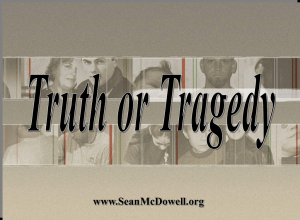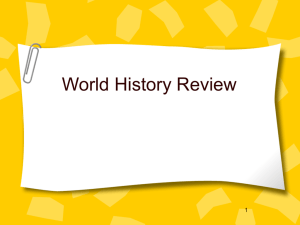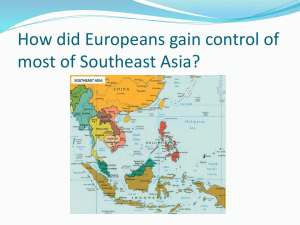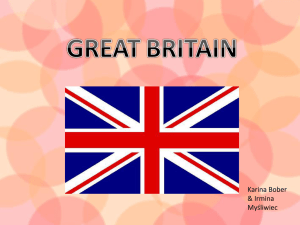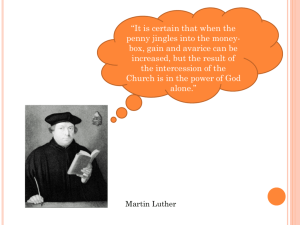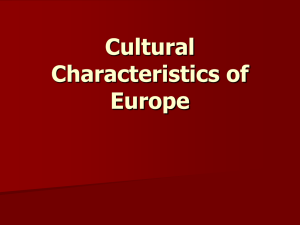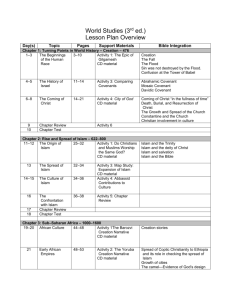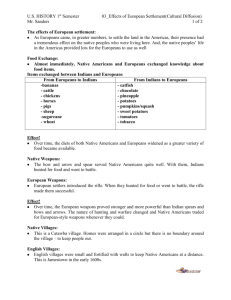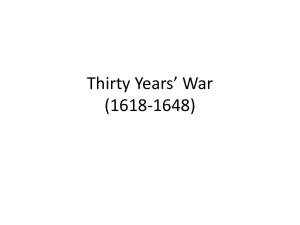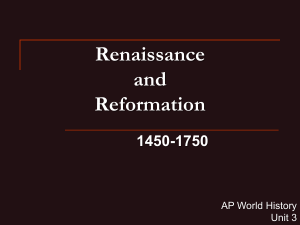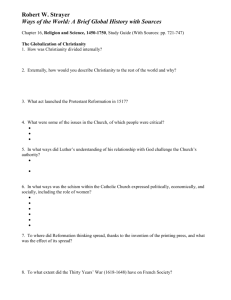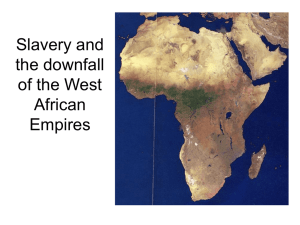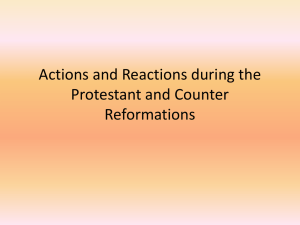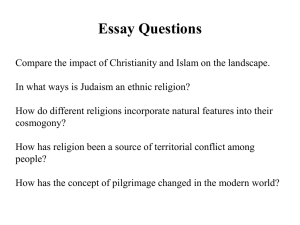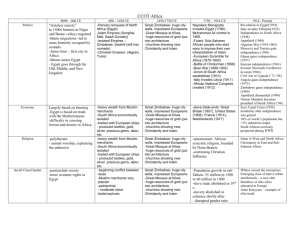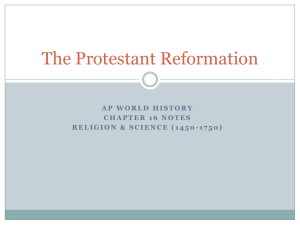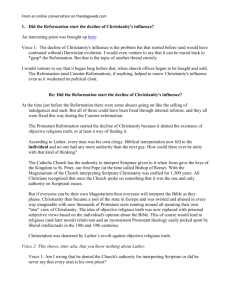Using your big picture notes, answer the following questions.
advertisement
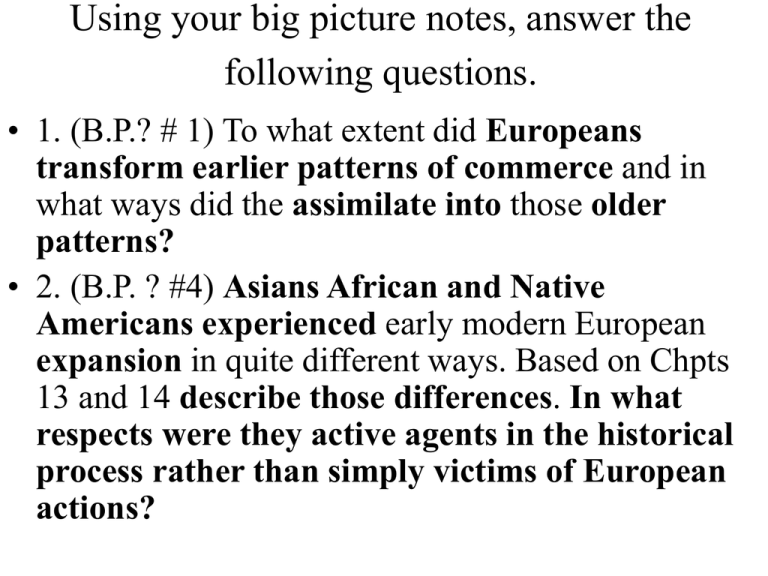
Using your big picture notes, answer the following questions. • 1. (B.P.? # 1) To what extent did Europeans transform earlier patterns of commerce and in what ways did the assimilate into those older patterns? • 2. (B.P. ? #4) Asians African and Native Americans experienced early modern European expansion in quite different ways. Based on Chpts 13 and 14 describe those differences. In what respects were they active agents in the historical process rather than simply victims of European actions? Question # 1 • Europeans for 1st time operated on global scale, creating new trade networks across the Atlantic and Pacific oceans. • included fur supplying regions in wider trade networks • Assimilated old patterns by becoming involved in the pre-existing Indian Ocean trade. Question # 2 • In Americas- Europe conquered completely. (politically and economically) due to the devastation of the Native populations (disease) and that Native technology could not rival Europeans. • In Africa – became part of a pre-existing slave trade. No effort to conquer large territories in Africa. Could be because West Africa offered to many tropical diseases. • Asia – Europeans sought “trading post empires”. Europeans controlled small islands or ports, but were unable to conquer large land territories. Shows the larger territories were to powerful for Europeans to control. Globalization of Christianity 1500 Christianity was mostly in Europe – there were small communities in Egypt, Ethiopia, and Central Asia. Schism – divisions btwn Roman Catholic and Eastern Orthodox. Both felt they had to be defensive against Islam. Loss of Holy land by 1300 Fall of Constantinople to the Ottomans in 1453 Ottoman siege of Vienna 1529 Western Christendom Fragmented: Protestant Reformation Printing press allows for more people to have access to the bible. 1517 – Martin Luther posts 95 Theses on the door of the Catholic Church. - protests the selling of indulgences, ?'s role of the clerical hierarchy ( including the pope. ) Protestant Reformation Led to Schism in Catholic Church Fed on political, economic, and social tensions, not just religious differences. Some monarchs used Luther to justify independence from the papacy Gave a new religious legitimacy to the middle class. Commoners attracted to new religious ideas as a tool to protest against social order. Role of women • Many women were attracted to Protestantism, but the Reformation didn't give them a greater role in church or society. • Protestants ended veneration (respect, reverence) of Mary and other female saints. • Protestants closed convents- which gave women an alternative to marriage. • Some increase in educations of women because of wanting to read the bible. Political divisions to the Reformation • 1562-1598 French Wars – Catholics vs ( Protestant minority) Huguenots. Ended with Henry VI issuing the Edict of Nantes ( religious tolerance of France) • 30 years war – 1618-1648 Initially, the war was fought largely as a religious conflict between Protestants and Catholics in the Holy Roman Empire, although disputes over the internal politics and balance of power within the Empire played a significant part. Fought primarily in what is now Germany, and at various points involved most countries in Europe. It was one of the most destructive conflicts in European history. - OVERALL: encouraged skepticism toward authority and tradition, fostered religious individualism, led to skepticism about all religions in some cases Council of Trent Catholic church was forced to make reforms - Corrected abuses and corruption of the clergy. - New emphasis on education and supervision of priests. - New attention given to individual spirituality Christianity expansion-Americas Benefited from European expansion. -Spanish and Portuguese saw overseas expansion of Christianity as a continuation of the crusades. - Population collapse, conquest, and resettlement made natives receptive to conquering religion. - Europeans tried to destroy previous native beliefs instead of accommodating them. - Met with resistance by natives. So, blending of the two religions was common. Local gods remained influential. - Christian saints took on functions of pre-colonial gods. - Leader of church staff was a prestigious native. Christianity- China - Reached China in the powerful Ming and Qing dynasties. - Missionaries sent because they needed government permission to operate. - Jesuits- Society of Jesus targeted Chinese Elite. - Jesuits shared western tech- astronomy, mathematics, science and visual arts with Chinese scholars and officials. Those were also most of the people who converted. - On the whole, Christianity was unappealing to Chinese pop due to it’s all or nothing idea that rejected a lot of Chinese cultural traditions. African Religions -Native African religions and practices came to the Americas with slaves. -divination, dream interpretation, visions and spirit possession. - Europeans tried to suppress these elements calling them sorcery. - Vodou- later Voodoo involves a blending of African religions with others. Islamic World Continued spread of Islam due to trade- not conquest. -Islands of SE Asia were difficult to convert due to diversity of native beliefs -syncretism of Islamization was offensive to orthodox Muslims led to movements of religious renewal. - Jihads in West Africa led to attack corrupt Islamic practices and growing tensions between localized and “pure” Islam. - Wahhabism- untra-conservative sect of Sunni Islam. Felt that Islam had moral decline and political weakness condemned what was perceived as idolatry, the popular cult of saints, and shrine and tomb visitation Less changed beliefs Confucianism and Hindu cultures didn’t spread so change was not as dramatic or evident. - Ming and Qing China still operated under Confucianism, however the addition of Buddhism and Doaist ideas blended with it, led to NEOConfucianism. - Change in culture and introduction of literature allowed for a new way of thinking= commoners and less educated to be more respected and have religious opportunities. India Movements brought Hindu and Muslims together. - Bhakti devotional Hinduism, effort to achieve union with (monotheistic) divine through song, prayers, dance, poetry, and rituals. - Appealed to women, set aside caste distinctions. Sikhism- combined Hindu and Muslim as one. Threw out classes and promoted equality of men and women. - Evolved as a militant community in response to hostility. Scientific Revolution Intellectual and cultural transformation. - Use scientific rev.ppt unit 10. Why Europe 800-1400 Islamic World was the most scientifically advanced. Before that China had the most advanced tech. -Why Europe?- evolution of legal system guaranteed independence for a variety of institutions. - Idea of corporation – collective group - Autonomy of universities allowing freedom to study what you choose - Due to the massive trade with so many other cultures, this exchange of information led to a new way of thinking. - Skeptism from protestant reformation led to seeking answers for how things worked instead of taking previous ideas.
